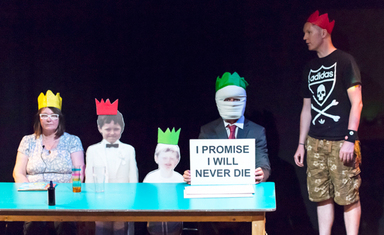To the tune of Roy Orbison’s In Dreams our three performers enter the space – there’s Feidlim Cannon (actor, director and co-founder of Brokentalkers theatre company) playing himself, his mother Ann playing herself, and an actor (introduced as Alan) playing their psychotherapist Eric Keller and other roles. The absent character at the heart of the show is Sean Cannon, father of Feidlim, husband of Ann. What plays out over the next 75 minutes is a beautiful, disturbing, and inspiring exploration of bereavement, loss, and grief. For all the heartbreak presented, it is ultimately life affirming – and a marvellous example of how terrible, painful life events can be explored in a theatrically successful way. Be warned: you’ll be left Crying along with Roy as the cast take their bows…
We start with a ‘not very good’ (Feidlim’s words) piece of video art, in which he tries to capture something of Sean’s spirit by filming a glass of Guinness placed in various locations (pubs, parks) beloved of his father. We also learn pretty quickly that there is a second absent character in this story: Little Sean, the youngest son of the family, who died not long after birth. There’s some very lovely questioning of how memory and imagination intertwine as Feidlim tells us that he remembers being lifted up to peer through the glass window at the hospital nursery to see his new baby brother, and Ann tells us – and him – that this couldn’t have happened. Little Sean (and the surviving middle son, Pádraig) are represented onstage by life-size photos pasted onto cardboard cut-outs.
One of the lovely aspects of the show is the constant re-casting of people, objects, and images. Feidlim plays himself but sometimes speaks Ann’s words. Alan is mostly the psychiatrist, but later morphs into an eerily bandaged Sean Cannon. Pádraig’s recorded voice features later, and baby Sean is not only a cardboard cut-out but also a doll – a Chucky doll, says Feidlim in disgust, accusing his mother of morbidity in her choice of objects (the doll is inside a cardboard box, representing the child’s coffin, which Feidlim hates). The story of his father Sean’s unnecessary and ultimately fatal hospital operation is played out with one of those horrid Operation Rescue Kit boardgames. Photos, fake snow and balloons also feature…
Whilst the story is ostensibly about the deaths of Sean senior and junior and the bereavement process, what it turns out to be mostly about is the mother-son relationship. Through fantastically drawn detail, Ann is framed onstage (by Feidlim’s words, through her own words, and in her remarkable calm and focused physical presence) as a wonderfully complex character: a Reiki practitioner who loves the colour purple and Australian soap operas; and then again a traditional Irish Catholic mother who teaches her children to cross themselves when they pass a church and who puts holy water on batteries to revive them.
Feidlim meanwhile rants against the world – terrified that he’ll be viewed as a ‘fucking Norman Bates still living with me mam’ in his thirties, and still feeling the pain of his dad’s foolish promise to his eldest son that he’ll ‘never die’.
One of the really interesting aspects of the show is the interaction between the three different performance modes – here we have an actor-director using his own autobiographical material, a non-actor performing, and an actor playing real characters in the other two performers’ stories. It’s Quarantine’s Susan and Darren and then some.
It’s a weird thing, painful personal memoir (on page or stage). Once you decide to put it out there, then it becomes your art, not just your life – and you have to be willing to craft it in a way that makes it something other people can own too. Have I No Mouth does this very effectively – a brilliant show, a worthy winner of a Total Theatre Award 2013.

